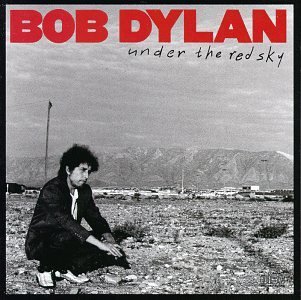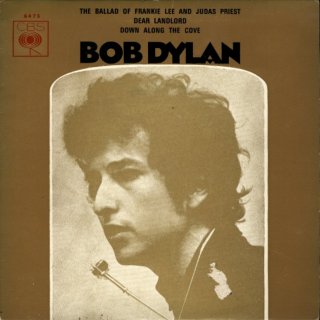"4th Time Around" is a song by American singer-songwriter Bob Dylan, which was released as the 12th track on his seventh studio album Blonde on Blonde on June 20, 1966. The song was written by Dylan and produced by Bob Johnston. Commentators often interpret it as a parody of the Beatles' 1965 song "Norwegian Wood ". John Lennon composed "Norwegian Wood" after being influenced by the introspective lyrics of Dylan. Lennon later reflected on his feelings of paranoia when Dylan first played him "4th Time Around".

Under the Red Sky is the 27th studio album by American singer-songwriter Bob Dylan, released on September 10, 1990, by Columbia Records. It was produced by Don Was, David Was, and Dylan.

World Gone Wrong is the 29th studio album by American singer-songwriter Bob Dylan, released on October 26, 1993, by Columbia Records.
"Absolutely Sweet Marie" is a song by American singer-songwriter Bob Dylan, which was released on the third side of the double album and Dylan's seventh studio album, Blonde on Blonde (1966). The song was written by Dylan and produced by Bob Johnston. It was recorded at around 1:00 am on March 8, 1966, at Columbia Studio A, Nashville. Some commentators have interpreted the song as being about sexual frustration.

"The Ballad of Frankie Lee and Judas Priest" is a song by American singer-songwriter Bob Dylan. It was released as the fifth track on his eighth studio album John Wesley Harding (1967). The track was written by Dylan and produced by Bob Johnston. It was recorded in one take on October 17, 1967, at Columbia Studio A in Nashville. The song's lyrics refer to two friends, Frankie Lee and Judas Priest. Lee asks Priest for a loan of money and Priest offers it freely. Lee spends it in a brothel over 16 days, then dies of thirst in Priest's arms. It has been suggested by commentators that the song refers to Dylan's relationship with his manager Albert Grossman or to his contractual negotiations with his record company. The song received a largely negative critical reception. Dylan has performed the song live in concert 20 times, from 1987 to 2000.
"Tombstone Blues" is a song by American singer-songwriter Bob Dylan, which was released as the second track on his sixth studio album Highway 61 Revisited (1965). The song was written by Dylan, and produced by Bob Johnston. Critical interpretations of the song have suggested that the song references the Vietnam War and US President Lyndon Baines Johnson.

"Stuck Inside of Mobile with the Memphis Blues Again" is a song by American singer-songwriter Bob Dylan from his seventh studio album, Blonde on Blonde (1966). The song was written by Dylan and produced by Bob Johnston. It has nine verses, each featuring a distinct set of characters and circumstances. All 20 takes of "Stuck Inside of Mobile with the Memphis Blues Again" were recorded in the early hours of February 17, 1966, at Columbia Records's A Studio in Nashville, Tennessee, with the last take selected for the album. This version also appears on Dylan's second compilation album, Bob Dylan's Greatest Hits Vol. II (1971).
"Dignity" is a song by Bob Dylan, first released on Bob Dylan's Greatest Hits Volume 3 on November 15, 1994, and also released as a CD single a month later. It was originally recorded in the spring of 1989 during the Oh Mercy studio sessions, but was not included on the album. It was also later anthologized on Dylan (2007).

"If Not for You" is a song by American singer-songwriter Bob Dylan from his October 1970 album New Morning. It was issued as the A-side of a single in Europe in early 1971. The song is a love song to Dylan's first wife, Sara Dylan. He recorded it several times in 1970; the session for the released version took place in New York in August. He also recorded the song with George Harrison on May 1, soon after the break-up of the Beatles, a session that attracted much speculation in the music press. The May recording remained unreleased until its inclusion on The Bootleg Series Volumes 1–3 in 1991.

"Most of the Time" is a song written and performed by American singer-songwriter Bob Dylan, released as the sixth track of his 1989 album Oh Mercy. The song was written by Dylan and produced by Daniel Lanois. The album version of "Most of the Time" was recorded on March 12, 1989, in a mobile studio at 1305 Soniat St., New Orleans, and released on Oh Mercy in September of that year. Two studio out-takes from the same set of recording sessions were released on The Bootleg Series Vol. 8: Tell Tale Signs: Rare and Unreleased 1989–2006 in 2008, and a new version recorded on March 16, 1990, was issued as a promotional single and video in 1990.

"Everything is Broken" is an uptempo rock song written and recorded by American singer-songwriter Bob Dylan, and released as the first single from his 1989 album Oh Mercy, where it appears as the third track. It was later anthologized on the compilation albums The Essential Bob Dylan in 2000 and Dylan in 2007. The song spent eight weeks on Billboard's "Mainstream Rock Songs" chart, peaking at number eight on October 27, 1989. It was produced by Daniel Lanois.
"Man in the Long Black Coat" is a song written and performed by American singer-songwriter Bob Dylan, released in 1989 as the fifth track on his album Oh Mercy. It is a minor-key folk ballad, often described as "haunting" and frequently cited as a highlight of the album. The song was produced by Daniel Lanois.
"Dirge" is a song by Bob Dylan. It was released on his 14th studio album Planet Waves in 1974. Notable for its acidic tone, "Dirge" has never been performed in concert.
"Nothing Was Delivered" is a song written by Bob Dylan that was originally recorded by Dylan and The Band in the Fall of 1967 during the sessions that generated The Basement Tapes. The song was first released by The Byrds on their 1968 album Sweetheart of the Rodeo.

"Obviously 5 Believers" is a song by American singer-songwriter Bob Dylan, which was released as the last track of side three of his double album Blonde on Blonde (1966), and was the B-side to the single release of "Just Like a Woman" for releases in America and some other countries. The song was written by Dylan and produced by Bob Johnston. It was recorded at Columbia Music Row Studios, in the early morning hours of a March 9–10, 1966 session. Four takes were recorded, although the first two were incomplete. It has been interpreted as a blues song about loneliness, with critics noting similarities in melody and structure to Memphis Minnie's "Chauffeur Blues". Dylan's vocals and the musicianship of the band on the track have both received critical acclaim, although the track has been regarded as insubstantial by some commentators.
"Ring Them Bells" is a song written and performed by American singer-songwriter Bob Dylan, released in 1989 as the fourth track on his album Oh Mercy. It is a piano-driven, hymn-like ballad that is considered by many to be the best song on Oh Mercy and it is the track from that album that has been covered the most by other artists.
"Shooting Star" is a song written and performed by American singer-songwriter Bob Dylan, released in 1989 as the tenth and final track on his album Oh Mercy. It was produced by Daniel Lanois.

"One More Cup of Coffee (Valley Below)" is a song by American singer-songwriter Bob Dylan, which was released as the fourth track on his seventeenth studio album Desire (1976). The song was written by Dylan, and produced by Don DeVito. The album version of "One More Cup of Coffee (Valley Below)" was recorded on July 30, 1975, and released on Desire in January 1976. Dylan said the song was influenced by his visit to a gypsy celebration at Saintes-Maries-de-la-Mer in France on his 34th birthday.
"I Shall Be Free No. 10" is a song by American singer-songwriter Bob Dylan, which was released as the fifth track on his fourth studio album Another Side of Bob Dylan (1964). The song was written by Dylan and produced by Tom Wilson. The song is a humorous talking blues, indebted to earlier songs including Lead Belly's "We Shall Be Free". Dylan opens the song by proclaiming that he is normal and average, but then acknowledges his reputation by singing the self-aware doggerel "Yippee! I'm a poet, and I know it/ Hope I don't blow it".









